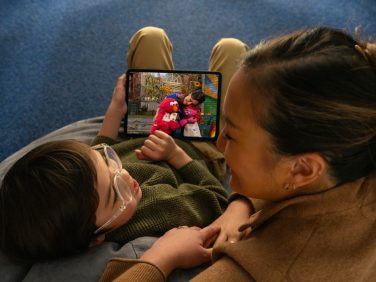
Digital Well-Being FAQ
- Home
- Our Work
- What We Do
- Emotional Well-Being
- Digital Well-Being FAQ
Frequently Asked Questions
What is digital well-being?
Digital well-being means using media and technology in ways that support health and overall well-being. Particularly for families of young children, digital well-being means understanding and using media and technology to learn, play, and feel closer to one another.
Why does digital well-being for families matter?
Parents often worry about managing children’s digital well-being and the possible negative impact of media and technology. They are concerned about children’s online safety, privacy, health, sleep patterns, family time, attention span, physical activity, social skills, and emotional self-regulation. And that’s understandable. Like all things, technology use can have positive or negative impacts on our lives. It’s how we approach it, with intention, that matters most.
The more we understand how digital well-being affects us, the healthier and more balanced our media use can become. It can be challenging to change or manage children’s digital habits once they’re formed, so it’s good to set the stage for digital well-being early, as soon as children begin to use media.
What are signs of too much screen time for toddlers and young children?
The American Academy of Pediatrics recommends caregivers limit screen use for children aged 2 to 5 to no more than 1 hour per day and provides tips for managing screen time for children. Symptoms of too much screen time can include your child being irritable or disinterested in non-digital activities or experiencing disrupted sleep patterns or difficulty concentrating.
Is video chatting with family members considered screen time?
Digital well-being for families looks different for everyone, and it isn’t only measured by how many minutes we spend on our screens each day. Determining how digital media can foster connection, and prioritizing those uses, is more important than simply measuring screen time. Especially for families of young children, digital well-being is about understanding and making choices about media as a part of family life… to learn, play, connect, relax, and feel closer to one another.
Engaging with others, staying in touch with friends and family far away, building relationships, deepening friendships — all are so important to children’s development and can represent healthy screen habits. There are many ways to prioritize these connections, and screens can be one tool. We can use screens to share moments big and small and show we care, especially when we are far apart. Technology can help us stay in touch with people we see every day as well as friends and family far away.
How can I help my child transition from screen time to other activities?
Transitions — like putting media and devices away or creating tech-free zones — can be tough to manage. For little ones, screen time is exciting, so it’s no surprise that they may have big feelings when it’s time to stop. This gets easier as they grow, but it takes practice.
Here are some things you can do to help make stepping away from the screen a little less intense.
A familiar routine, like our Switch It! Strategy, can help with transitioning to tech-free family time. Adding motions — clapping your hands or stomping your feet, giving a big stretch, and a little jump when it’s time to switch — can make these steps really stick!
How can I create a balanced tech environment at home?
Deciding what digital well-being looks like for your family involves many factors, and it’s not always easy to figure out. You can start creating a balanced tech environment at home by simply explaining the concept of needs and wants in the digital world. This helps children begin to understand the difference between the two:
- Needs are the things that keep us healthy and safe. Media is a need when it helps us complete tasks, like ordering groceries or getting directions.
- Wants are things we can wait for or things we can choose not to have at all. Media is a want when we use it for passing time, like playing video games or watching videos.

